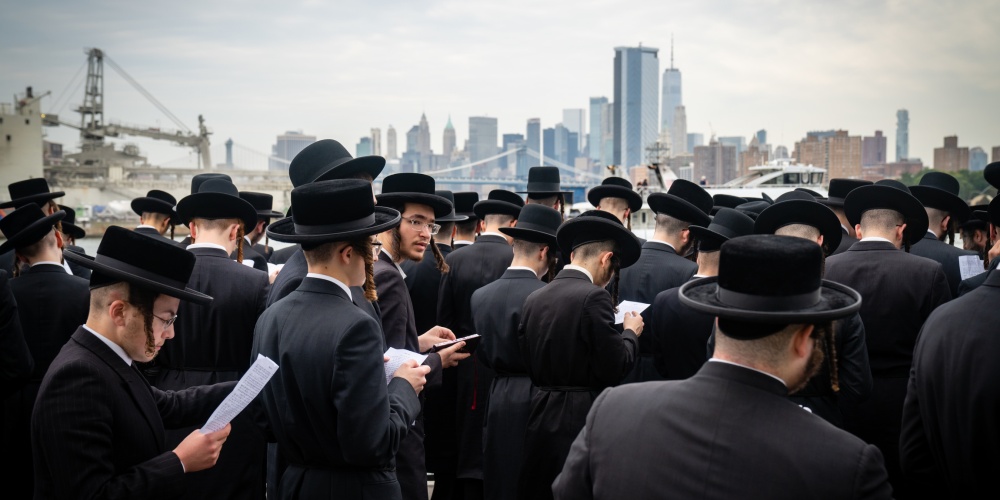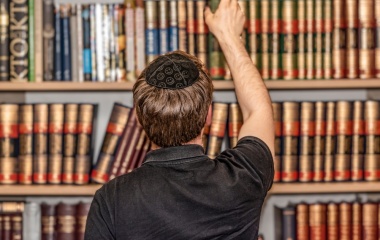
In our post discussing the last lines of the Talmud Bavli, we wondered why the Gemara ends with a teaching by Eliyahu Hanavi. As Daf Yomi begins its 14th cycle and we open up masechet Brachot, it does not take us long—one page, to be exact—until we meet up with Eliyahu once again. In masechet Nidah, Eliyahu taught that all who study (and review) halacha, Jewish law, every day are guaranteed a place in the World-to-Come; in masechet Brachot, he actually teaches us halachot.
“Rabbi Yossi said: I was once walking along the road when I entered one of the ruins among the ruins of Jerusalem to pray. Eliyahu, he should be remembered for good, came and guarded the entrance for me and waited at the entrance until I finished my prayer. When I finished praying, he said to me, Greetings to you, my Rabbi! I answered him: Greetings to you, my Rabbi, my teacher. And he said to me: My son, why did you enter this ruin? I said to him: to pray. He said to me: You should have prayed on the road. And I said to him: I was afraid that travelers might interrupt me. He said to me: You should have recited an abbreviated prayer” (Brachot 3a) .
Rav Yossi noted that “at that time, I learned three things. I learned that one should not enter a ruin, I learned that one may pray, baderech, on the way, and that one who prays on the derech should pray a shortened prayer.”
Rav Yossi, a student of Rabbi Akiva, witnessed the crushing of the Bar-Kochva revolt. Jerusalem was in ruins, its batei midrash and bati knessiot destroyed and the hope that the third Temple would soon be rebuilt dashed. Rav Yossi entered a ruin to pray. How sadly fitting. There was much to pray for and much to lament. But prayers and ruins do not go together. Ruins remind us of what once was; prayer is about what can be[1]. We cannot change the past, but we can mould the future. Whatever impact our prayers may or may not have on G-d and His actions, prayer is meant to inspire us to move forward and act. Prayer should invigorate us so that we seek ways to increase wisdom, ask forgiveness from those we have wronged, to forgive others, adopt a healthy lifestyle, work towards our economic success, fight for justice, help build Jerusalem, do our best to uproot evil and seek peace. We can do all that ourselves, or at least give it our best shot. The more we do, the more confident we can feel when we ask G-d “to hear our prayers”.
Such cannot be done in a ruin. “And when I cry and plead, He shuts out my prayer” (Eicha 3:8). Tisha B’Av is a day of mourning, a day when our prayers are “shut out” and cannot reach heaven. Based on this verse, we do not say titkabel, asking G-d to hear our prayers on Tisha B’Av, the day the Temple was left in ruins. Similarly, a mourner leaves out titkabel when reciting kaddish. If prayer depresses us—and the ruins of Jerusalem are meant to do just that—we will draw more distant from G-d, making our task more difficult. “The Divine Presence rests not from sadness, nor from laziness, nor from laughter, nor from frivolity, nor from idle conversation, nor from idle chatter, but rather, from the joy of a mitzvah” (Shabbat 30b).
While Rav Yossi was mistakenly praying in a ruin, Eliyahu patiently waited at the entrance, refusing—or might we say, unable—to enter the ruin. Eliyahu represents our future, the heralding of the Messianic Age and the blessings of peace. He cannot be found in a ruin.
After teaching him the above three halachot, Eliyahu asked Rav Yossi what he heard while in the ruin. “I heard”, Rav Yossi answered, “a Heavenly voice, cooing like a dove and saying: “Woe to Me, that due to their sins I destroyed My house, burned My Temple, and exiled them among the nations”. A ruin is a place of mourning, where G-d laments what has happened to His people. With man manadated to Imitate G-d, it is a place where man, too, can lament what has happened to his people. But it is not the place of prayer[2].
Eliyahu then informed Rav Yossi that G-d was crying not only then and there, but that He does so three times a day. Tellingly, these three times do not correspond to our three daily prayers, but to three times throughout the night. Lamentation and prayer must be kept separate.
“Rabbi Yocḥanan said: Who is a child of the World-to-Come? It is one who juxtaposes redemption [even] to the evening prayer” (Brachot 4b). The immediate blessing before we daven—tefillah means the amidah[3]—is that of ga’al Yisrael, blessed is the One who redeems Israel. Before we pray, we must remind ourselves of the glorious moments of Jewish history. We recall our past redemptions and look forward to the redemption in the future. “In Nissan we were redeemed, and in Nissan we will be redeemed”. We look forward to greeting Eliyahu as he joins us in the rebuilt Jerusalem, singing together to G-d.
[1] There are times we must focus on the past, kinnot being the best example. Throughout history, there were pious Jews who awoke at midnight to lament the loss of the Temple. But even in these examples invoking the past must serve as an impetus for us to do better in the future.
[2] The Gemara gives three reasons why, prayer or no prayer, one should never enter a ruin.
[3] The other parts of the siddur are not actually prayer, but things we say in conjunction with prayer. For example, birchat hashachar are blessings of praise to G-d; pesukei d’zimrah get us in the mood for prayer; kriat shema is the acceptance of G-d and His commandments. They are all important, but they do not constitute “prayer”.



